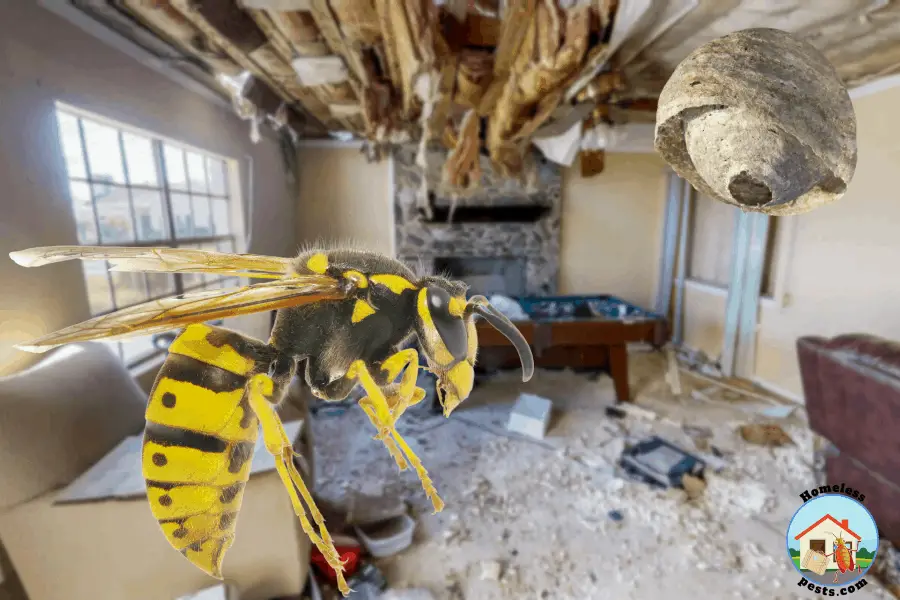
Wasps are generally seen as an annoyance when you are spending a lovely day in your yard with the family, but these pests could also pose a much more alarming threat to your home.
If you have a wasp nest in your roof or around your property, exactly how much risk does it pose to your home and its very structural integrity?
The presence of wasps in your roof or other parts of your home can lead to significant damage to the superstructure of the building. Damage is either caused by the insects chewing through various materials while building their nest or through moisture-related damage caused by the presence of the nest in roofs or walls.
Wasps and their nests can actually cause damage to your home in different places and different ways, so be sure to continue reading to find out more.
What should you do if you find a wasp nest in your home?

Although wasps play a crucial role in nature and you should never both their nests usually, it’s a different story when they invade your home.
Wasps will normally become more active in the spring and this is when they start building their nests, often in places that are warm and dry, such as under eaves or in the ceiling.
Now if you find a wasp nest inside your home it’s important to take action promptly because their nests can cause structural damage just because of how they are constructed and their presence over time.
Try to identify the location of where they are building their nest, then take steps to remove the wasps and their nest. If you want to do this yourself, you can find out more information about how to remove a wasp nest in my other article here.
However, attacking a wasp nest can be quite dangerous and you should always use a professional pest exterminator to get rid of the wasps unless completely sure of what you are doing.
Generally, if you find them on your property, call pest control company before attempting any sort removal yourself!

Can Wasps break through walls?
Wasps are certainly capable of breaking through walls of many different materials from plasterboard to wood and even brick. However, they will only do this when feeling agitated or desperate. Often this happens when owners block up the entrance to a nest or make a failed attempt to kill them with aerosols.
In addition to making nests on the interior and exterior of roofs, some wasp nests are built inside wall spaces. This often happens if your walls have cracks in them, often in the mortar of brick walls, or if there are gaps in the plaster.
This provides a perfect opportunity for wasps to build their nests and you may not even know it’s happening until they become so large that at some point an outer wall of your house becomes wet from a damp wasp nest!
Wasp nests inside wall spaces can usually be detected by either seeing the wasps flying in and out of a gap or through the presence of a wasp-like buzzing sound from inside your home.
This is because the nest will be full to bursting with all sorts and it’s not unusual for them to build nests containing thousands or even millions, billions! If you see this sort of behavior around your home then contact pest control ASAP as they can cause major structural damage if their number grows.
Why call pest control? Well, unlike nests in easy-to-access places, attacking a wasp nest inside a wall without the right tools could be disastrous. Not only could you fail to kill the wasps, but you could also be unable to remove the nest itself.
If you don’t kill the wasps, but instead just plug up their entrance, they will seek another way to exit possibly by breaking through a wall into your home. If you do manage to kill all the wasps, they will end up rotting inside your walls possibly causing mold and other things which will damage your walls from the inside out.
Also, The nest itself can produce secretions which lead to dampness in your walls. Even leaving an intact nest inside the ways could lead to it getting damp and then weakening the wall structure through that moisture.
That’s why it is important to call in a professional pest control company if you know there are wasps on your property. Leaving them untreated can result not only in structural damage but also injuries and illness from the venomous stingers they carry, especially for children who may be unaware of their presence or just how dangerous these insects really are!
Do wasps damage wood?

Many species of wasp will significantly damage the wood inside your home. This happens in two ways, firstly by the wasps chewing on the wood to create a paper-like material to build their nests, and through the nest themselves. Wasp nests get damp, usually, when dormant, this can lead to any wood it’s attached to rotting away over time.
Usually, a wasp nest will only be active for a few months over spring and summer. When the worker wasps die off or the queen relocates, a vacant nest can still pose a problem.
The nests can also get damp and cause structural damage to walls through that moisture because it weakens wall structures from the inside out as well! This is why you should call an experienced pest control company if there are any signs or sightings of wasps as they are more likely to do a perfect job than the average house owner.
In addition to the issue with a dormant nest, the wasps themselves, especially some species, can be as bad as a termite infestation. This is because they chew on wooden beams and other structures.
If a roof space becomes a regular place for wasps to nest, which is more than possible, over time these insects could significantly undermine beams and other wooden structural supports.
This is why it’s worth calling in an expert to survey your home after any wasp nest has been removed, especially if you haven’t lived in the home long. You never know how the previous owners dealt with similar issues.
Can wasps eat through drywall?
Wasps can and certainly do eat their way through drywall, but it’s usually in response to an attack on their nest. When wasps can no longer exit their nest due to a human laid obstruction, they will gnaw through anything to get out. So, early detection of wasps nests is key.
The truth is that although wasps may be small, they are numerous. Colonies can quite easily chew through your drywall if they need to and this can lead to quite a lot of damage in the long run.
Not only this but they will chew through whatever may be under that drywall, from wires to plastic tubes. It may take time and that is perhaps the only thing that you have on your side to minimize the damage they can cause.

Do wasps damage roofs?
Wasp damage to roofs is a real possibility, but it can come in several different forms. While wasps are constructing their nest they can strip off layers of wood from beams and support. Their nests can be a breeding ground of dampness, leading to mold and rot. Nest can also cause condensation if they block air circulation outlets.
In short, a wasp nest in your roof is bad news. Whenever you find one, it’s important to have it removed fast. By far the best option is to call in a professional, but if you’re considering doing the work yourself there are two things to consider:
A) Only attempt to exterminate wasps when they are less active, the early morning or early evening are ideal times.
B) Buy a branded wasp killer which you can spray a far distance, which means you don’t need to get up close and personal while they are still alive.
Doing all of the above will minimize the risk to yourself, your family, and your pets. Remember: don’t panic! If they are in a nest then you should be confident that it can easily be taken care of with minimal fuss or expense…unless their population is out of control which means maybe call someone who knows what there doing.
Do wasps nest in brickwork?

Wasps can build nests within brickwork and normally gain access through cracks or loose mortar. As the nest expands, the wasps can undermine the internal structure of the brick wall, which could eventually lead to collapse. When you see wasps flying in and out of a brick wall, you should act quickly to exterminate them.
Wasps just want a safe and dry place to build a home and raise their young. We actually want wasps in the world and ordinarily, we shouldn’t disturb them. But when they build their nest in your brick walls, they can cause structural damage and must be removed.
Usually, I would say that this is going to be more successfully done by a professional than by an amateur. Working with a pest control service will probably mean that you won’t have to knock down a wall when you mess up and fail to remove the wasp and nest properly.
How do you know if you have wasps in your walls?
The easiest way to tell that wasps are living in your walls is to see or hear them, although in reality, it’s the sound that will most likely alert you to this infestation.
A colony of wasps will emit a low buzzing sound as they go about their work. You’ll also tend to notice a lot more wasps than normal if a nest is located on your own property.
If you start to see wasps inside your home even though the doors and windows are closed and the wasps are not known to have a history of being on your property, you might want to call in pest control specialists. It’s possible that they have actually broken through a wall and have an exit into your house as well as out of it!
How do I get rid of wasps in my wall?
If you have wasps in your walls, you can try to use a wasp killer product and spray it through an entrance, but this probably isn’t going to be as effective as for other locations for nests.
Honestly, if you have this issue, you need to bite the bullet and call in a professional pest control team as they are going to do a much better job than you for this particular nest.
In other scenarios, I’d say that most people can tackle an easy-to-access nest. For more information about how to do this, please read my other article on removing wasp nests from roofs.
Just as some general advice, however, when dealing with wasps please bear this in mind:
1) Never disturb wasps unless they have built their nest inside your property. The stings are real and you only need to risk them when the threat to your home is real
2) Be careful not to damage anything when removing it – a foot in the wrong place can be worse than leaving the nest there.






